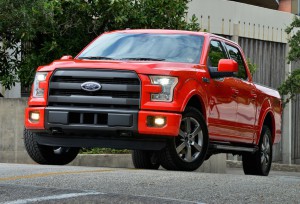
Ford's 2015 F-150 4x2 with Ford’s 2.7-liter EcoBoost engine has EPA-estimated ratings of 19 mpg City, 26 mpg Highway and 22 mpg Combined.
With newly released EPA test numbers in hand, Ford Motor Co. has declared its 2015 F-150 the nation’s most fuel-efficient gas-powered full-size pickup truck.
Based on EPA numbers and what Ford billed as apples-to-apples comparisons, the new aluminum-bodies F-150 will get anywhere from 5% to 29% better mileage – in some cases as much as 7 mpg – over the prior model.
That’s “a significant achievement,” declared Ford’s global product development director Raj Nair, especially when taking into account the fact that the average new 2015 F-150 will also see an increase in both towing and cargo capacity.
Ford has been promising to deliver a big bump in mileage ever since revealing its plan to migrate from a conventional steel to aluminum-bodied truck. That move can save as much as 700 pounds per vehicle. The company sought to strike a balance that would boost capabilities – a big issue with buyers – as well as mileage.

Using EcoBoost engine technology, the F-150 now tows as much as 1,100 more pounds and hauls as much as 530 pounds more than today’s model.
Ford did not get to claim the most fuel-efficient full-size truck overall, however. That honor still belongs to the Ram 1500 EcoDiesel produced by rival Fiat Chrysler Automobiles, which gets up to a maximum 20 City, 28 Highway and 23 Combined in its base configuration. The new F-150 gets up to 19/26/22 with a 2.7-liter EcoBoost engine in a base 4×2 version of the truck.
Product chief Nair downplayed the Ram’s advantage by noting that diesel has been running an average 38 cents a gallon more than gasoline during the past year. At the same time, the EcoDiesel is a $4,770 option compared to $495 for the 2.7-liter turbocharged EcoBoost engine. That completely wipes out the fuel savings, Ford officials stressed during a Friday morning news conference in Dearborn, Michigan.
“For our customers, fuel efficiency is measured at the wallet,” argued Nair.
Even with the more expensive Ford EcoBoost 3.5-liter V-6, he added, it would take about 15 years, at the current diesel-gasoline price gap to achieve “payback” for the Ram EcoDiesel.
The gains made by the 2015 Ford F-150 depend upon model, and it can be a challenge to come up with precise numbers because it requires factoring in significant changes in the new model’s engine line-up. The new 2.7-liter EcoBoost V-6 gets as much as 19 City, 26 Highway and 22 Combined – a 29% increase if compared to Ford’s old, naturally aspirated V-8.
Nair did note that Ford is working to squeeze even more mileage out of the new full-size truck as it faces down tough new federal fuel-economy mandates. Among the options that could show up in the near future is an all-new 10-speed automatic transmission the maker is developing as part of a joint venture with erstwhile rival General Motors.
It also is looking at even more exotic solutions such as an active aero system that would clean up airflow around the wheels. But the tough duty cycle trucks face will likely make that technology appear first on a passenger car, rather than on a work truck, Nair cautioned.
Meanwhile, the maker is looking at yet other powertrain options, and the product boss noted that, “We do anticipate by the end of this decade we’d have a hybrid F-150.”
The lowest mileage on the new F-150 comes with the big 5.0-liter V-8 on a 4×4 package, delivering just 15 mpg City, 21 City and 17 Combined, according to the new EPA data.
But V-8s are becoming less and less of the truck’s mix, accounting for barely 40% of total F-150 sales last year. Among the various V-6 options, the EcoBoost models are currently at 28%, but that’s expected to improve for 2015 with the addition of the new 2.7-liter turbocharged powertrain, Ford is forecasting.
(Ford F-150, BMW i8 capture Innovation Vehicle awards. For more, Click Here.)
For the coming year, Ford plans to offer at least one version of its EcoBoost engine family on 90% of its North American models.
(Click Here for details on Fisker’s return with a 725-hp Mustang.)
The big jump in fuel economy could prove critical as Ford sets out to sell the new version of what has been America’s best-selling truck for three decades. The maker has to overcome some concerns about long-term reliability, durability and operating costs, as well.
(To see more the Volvo V60 Cross Country carving out a new niche for wagons, Click Here.)
But Ford insists that the public response to the new 2015 F-150 has been strong. The test will start in the months ahead. During the Friday morning news conference, Ford announced the first “salable” trucks are now coming off the assembly line at the Dearborn Truck Plant. It expects to deliver the first of the pickups to a retail customer sometime next week.

Being assigned to make accurate corporate MPG projections for vehicles with as many driveline combinations as pickup trucks strikes me as cruel, unusual and Dickensian.